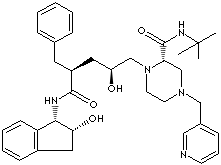|
INDINAVIR SULFATE |
| Synonyms. Indinavir Sulfate; (alphaR,gammaS,2S)-alpha-Benzyl-2-(tert-butylcarbamoyl)- gamma-hydroxy-N-((1S,2R)-2-hydroxy-1-indanyl)-4-(3-pyridylmethyl)-1- piperazinevaleramide sulfate; Crixivan; 2,3,5-Trideoxy-N-((1S,2R)-2,3-dihydro-2-hydroxy-1H-inden-1-yl)- 5-((2S)-2-(((1,1-dimethylethyl)amino)carbonyl)-4-( 3-pyridinylmethyl)-1-piperazinyl)-2-(phenylmethyl)-D-erythro-pentonamide sulfate |
|
|
| PRODUCT IDENTIFICATION |
|
|
CAS RN |
150378-17-9 (parent), 157810-81-6 (sulfate), 180683-37-8 (hydrate) |
|
EINECS RN |
207-586-9 |
|
FORMULA |
C36H47N5O4·H2SO4 |
|
MOLE WEIGHT |
711.87 |
|
H.S CODE |
2933.59.3600 |
|
SMILES |
c12[C@@H]([C@H](O)Cc1cccc2)NC([C@@H](Cc1ccccc1)
C[C@@H](C[N@@]1[C@@H](C[N@@](Cc2cccnc2)CC1)C(NC(C)(C)C)
=O)O)=O.S(O)(O)(=O)=O |
|
CLASSIFICATION |
Antiretroviral, Antiviral, Protease inhibitor, |
|
EXTRA NOTES |
A potent and specific HIV protease inhibitor that appears to have good oral bioavailability. |
|
|
| PHYSICAL AND CHEMICAL PROPERTIES |
|
|
PHYSICAL STATE. |
white crystalline powder |
|
MELTING POINT |
150 - 153 C |
|
BOILING POINT |
|
|
DENSITY |
|
|
SOLUBILITY IN WATER |
|
| SOLVENT SOLUBILITY | |
|
VAPOR DENSITY |
|
|
log P(octanol-water) |
|
|
VAPOR PRESSURE |
|
|
AUTOIGNITION TEMP |
|
| pH |
|
|
REFRACTIVE INDEX |
|
|
FLASH POINT |
|
|
|
| STABILITY AND REACTIVITY | |
| STABILITY | Stable under normal conditions. |
|
INCOMPATIBLE MATERIALS |
Oxidizing agents |
| POLYMERIZATION |
Has not been reported |
|
NFPA RATINGS |
|
|
|
| EXTERNAL LINKS & GENERAL DESCRIPTION |
|
Drug Information Portal (U.S. National Library of Medicine) - Indinavir PubChem Compound Summary - Indinavir sulfate Drug Bank - Indinavir KEGG (Kyoto Encyclopedia of Genes and Genomes) - Indinavir http://www.ebi.ac.uk/chebi/ - Indinavir http://www.ncbi.nlm.nih.gov/ - Indinavir http://www.antimicrobe.org/ http://www.medicinenet.com/ |
|
|
| SALES SPECIFICATION |
|
|
APPEARANCE |
white crystalline powder |
|
PURITY |
99.0% min |
|
|
| TRANSPORT & REGULATORY INFORMATION |
|
|
UN NO. |
Not regulated |
| HAZARD SYMBOL |
|
| PACKING GROUP | |
|
|
| SAFETY INFORMATION |
|
|
HAZARD OVERVIEW |
Not known |
|
GHS |
|
|
SIGNAL WORD |
|
|
PICTOGRAMS |
|
|
HAZARD STATEMENTS |
|
|
P STATEMENTS |
|
| EC DIRECTIVES |
|
| HAZARD CODES |
|
|
RISK PHRASES |
|
|
SAFETY PHRASES |
|
|
|
| PACKING |
|
|
|
|
| PRICE INFORMATION |
|
|
